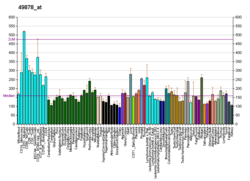Peroxisomal membrane protein PEX16 is a protein that in humans is encoded by the PEX16 gene.
Function
The protein encoded by this gene is an integral peroxisomal membrane protein. An inactivating nonsense mutation localized to this gene was observed in a patient with Zellweger syndrome of the complementation group CGD/CG9. Expression of this gene product morphologically and biochemically restores the formation of new peroxisomes, suggesting a role in peroxisome organization and biogenesis. Alternative splicing has been observed for this gene and two variants have been described.
Interactions
PEX16 has been shown to interact with PEX19.
References
- ^ GRCh38: Ensembl release 89: ENSG00000121680 – Ensembl, May 2017
- ^ GRCm38: Ensembl release 89: ENSMUSG00000027222 – Ensembl, May 2017
- "Human PubMed Reference:". National Center for Biotechnology Information, U.S. National Library of Medicine.
- "Mouse PubMed Reference:". National Center for Biotechnology Information, U.S. National Library of Medicine.
- South ST, Gould SJ (Mar 1999). "Peroxisome Synthesis in the Absence of Preexisting Peroxisomes". J Cell Biol. 144 (2): 255–66. doi:10.1083/jcb.144.2.255. PMC 2132891. PMID 9922452.
- ^ "Entrez Gene: PEX16 peroxisomal biogenesis factor 16".
- Fransen, M; Wylin T; Brees C; Mannaerts G P; Van Veldhoven P P (Jul 2001). "Human Pex19p Binds Peroxisomal Integral Membrane Proteins at Regions Distinct from Their Sorting Sequences". Mol. Cell. Biol. 21 (13): 4413–24. doi:10.1128/MCB.21.13.4413-4424.2001. ISSN 0270-7306. PMC 87101. PMID 11390669.
Further reading
- Honsho M, Tamura S, Shimozawa N, et al. (1999). "Mutation in PEX16 is causal in the peroxisome-deficient Zellweger syndrome of complementation group D". Am. J. Hum. Genet. 63 (6): 1622–30. doi:10.1086/302161. PMC 1377633. PMID 9837814.
- Sacksteder KA, Jones JM, South ST, et al. (2000). "Pex19 Binds Multiple Peroxisomal Membrane Proteins, Is Predominantly Cytoplasmic, and Is Required for Peroxisome Membrane Synthesis". J. Cell Biol. 148 (5): 931–44. doi:10.1083/jcb.148.5.931. PMC 2174547. PMID 10704444.
- Fransen M, Wylin T, Brees C, et al. (2001). "Human Pex19p Binds Peroxisomal Integral Membrane Proteins at Regions Distinct from Their Sorting Sequences". Mol. Cell. Biol. 21 (13): 4413–24. doi:10.1128/MCB.21.13.4413-4424.2001. PMC 87101. PMID 11390669.
- Shimozawa N, Nagase T, Takemoto Y, et al. (2002). "A novel aberrant splicing mutation of the PEX16 gene in two patients with Zellweger syndrome". Biochem. Biophys. Res. Commun. 292 (1): 109–12. doi:10.1006/bbrc.2002.6642. PMID 11890679.
- Fransen M, Brees C, Ghys K, et al. (2002). "Analysis of mammalian peroxin interactions using a non-transcription-based bacterial two-hybrid assay". Mol. Cell. Proteomics. 1 (3): 243–52. doi:10.1074/mcp.M100025-MCP200. PMID 12096124.
- Honsho M, Hiroshige T, Fujiki Y (2003). "The membrane biogenesis peroxin Pex16p. Topogenesis and functional roles in peroxisomal membrane assembly". J. Biol. Chem. 277 (46): 44513–24. doi:10.1074/jbc.M206139200. PMID 12223482.
- Strausberg RL, Feingold EA, Grouse LH, et al. (2003). "Generation and initial analysis of more than 15,000 full-length human and mouse cDNA sequences". Proc. Natl. Acad. Sci. U.S.A. 99 (26): 16899–903. Bibcode:2002PNAS...9916899M. doi:10.1073/pnas.242603899. PMC 139241. PMID 12477932.
- Jones JM, Morrell JC, Gould SJ (2004). "PEX19 is a predominantly cytosolic chaperone and import receptor for class 1 peroxisomal membrane proteins". J. Cell Biol. 164 (1): 57–67. doi:10.1083/jcb.200304111. PMC 2171958. PMID 14709540.
- Gerhard DS, Wagner L, Feingold EA, et al. (2004). "The Status, Quality, and Expansion of the NIH Full-Length cDNA Project: The Mammalian Gene Collection (MGC)". Genome Res. 14 (10B): 2121–7. doi:10.1101/gr.2596504. PMC 528928. PMID 15489334.
- Fransen M, Vastiau I, Brees C, et al. (2005). "Analysis of human Pex19p's domain structure by pentapeptide scanning mutagenesis". J. Mol. Biol. 346 (5): 1275–86. doi:10.1016/j.jmb.2005.01.013. PMID 15713480.
- Brocard CB, Boucher KK, Jedeszko C, et al. (2005). "Requirement for microtubules and dynein motors in the earliest stages of peroxisome biogenesis". Traffic. 6 (5): 386–95. doi:10.1111/j.1600-0854.2005.00283.x. PMID 15813749. S2CID 24667495.
- Rual JF, Venkatesan K, Hao T, et al. (2005). "Towards a proteome-scale map of the human protein-protein interaction network". Nature. 437 (7062): 1173–8. Bibcode:2005Natur.437.1173R. doi:10.1038/nature04209. PMID 16189514. S2CID 4427026.
- Kim PK, Mullen RT, Schumann U, Lippincott-Schwartz J (2006). "The origin and maintenance of mammalian peroxisomes involves a de novo PEX16-dependent pathway from the ER". J. Cell Biol. 173 (4): 521–32. doi:10.1083/jcb.200601036. PMC 2063862. PMID 16717127.
External links
- GeneReviews/NCBI/NIH/UW entry on Peroxisome Biogenesis Disorders, Zellweger Syndrome Spectrum
- OMIM entries on Peroxisome Biogenesis Disorders, Zellweger Syndrome Spectrum
This article on a gene on human chromosome 11 is a stub. You can help Misplaced Pages by expanding it. |






